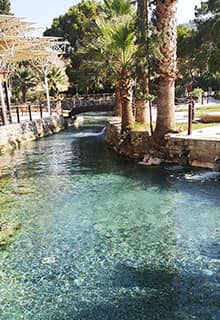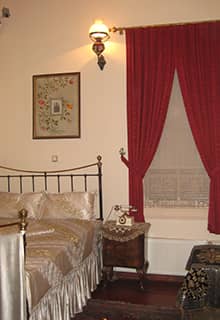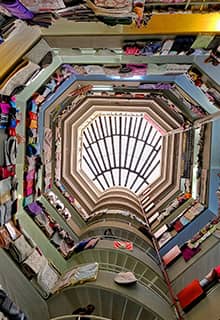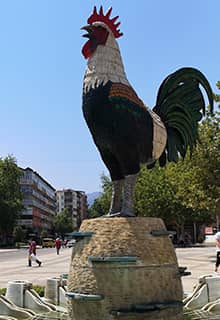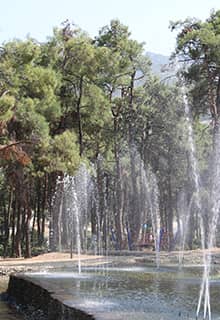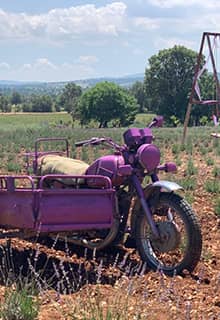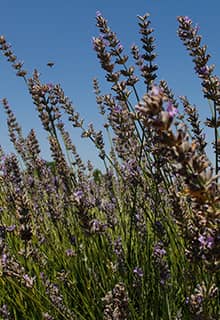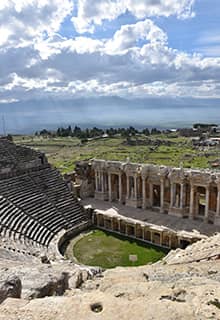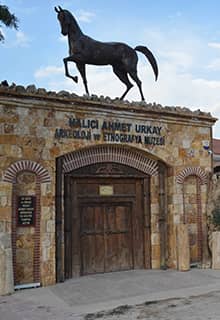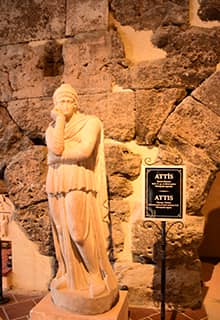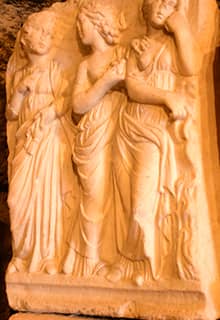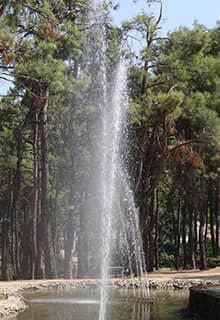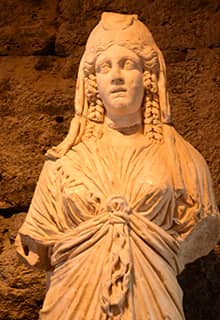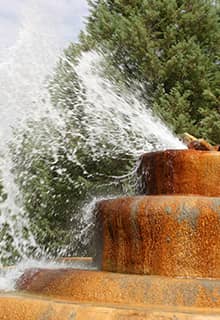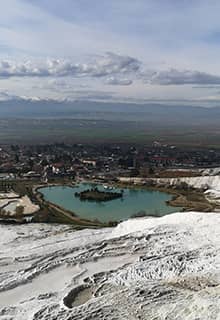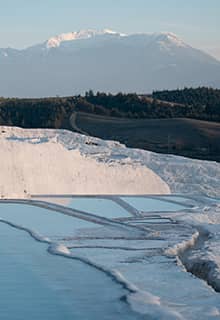

see
Pamukkale
Pamukkale Travertines
Pamukkale features magnificent white travertines which are formed when the thermal water supersaturated with calcium carbonate comes into contact with the oxygen on the surface creating shapes similar to frozen waterfalls and small pools resembling terraces. Pamukkale is included in almost all lists of “must-see places”! Throughout history, people have known about the healing properties of the thermal waters of Pamukkale and have stayed in Hierapolis for receiving treatment. Touching the travertines themselves, which are as white as snow and which are formed by the thermal water regenerating from Hierapolis, is also quite an experience! Currently, the Pamukkale travertines are mostly under preservation in order to avoid any deterioration in the originality of their natural beauty. Resembling a fabulous field of snow-white clouds, their natural beauty is rare and they represent a location where history and nature embrace. Another highly recommended local experience is to swim in the Antique Pool, also known as Cleopatra’s Pool, next to the Pamukkale travertines. The calcareous structure, white color, and warm thermal water is a one-of-a-kind experience! It is without a doubt that you will be enchanted by Pamukkale’s many beauties and attractions!
Ancient City of Hierapolis
Located 18 km north of Denizli, within the same site as the Pamukkale travertines, the ancient city of Hierapolis is considered a “holy city” due to the presence of temples and religious structures. It was founded by Eumenes II, king of Pergamum, in the beginning of the 2nd century BC and was named after Hiera, the wife of Telephus, ’s Attalid dynasty. The hot springs of Hierapolis, which was a thermal center in ancient times, have been visited by people from different parts of Anatolia for thousands of years in search of health, healing treatments, and beauty. Today, the thermal pools are also visited for beauty and health. Structures worth visiting here include the Gymnasium, the Pamukkale Observation Terrace, the travertines, the Martyrium & Church of Saint Philip the Apostle, the Hierapolis Ancient Theater, the Hierapolis Archaeological Museum, the Antique Pool (Cleopatra’s Pool), the Northern Necropolis, the Frontinus Gate and Street,
Hierapolis Ancient Theater
The ancient theater at Hierapolis dates back 2,500 years. It is unique among other Anatolian theaters from the Roman period in the Mediterranean thanks to its unique mythological reliefs, magnificent stage building, and the cavea, the tiered semicircular seating space. On the sculptural reliefs decorating the theater the following mythological scenes are depicted: the birth of Apollo and Artemis and religious rites, entertainment relating to the god Dionysus, Satyrs and Maenads, the music competition between Marsyas and Apollo, the battle between the Olympian gods and the Giants (Gigantomachy), Hades abducting Persephone to take her to the Underworld, sport competitions held in Hierapolis, and the coronation ceremony of Emperor Septimius Severus.
Antique Pool (Cleopatra’s Pool)
The Antique Pool, which dates back to the 2nd century BC, is located 18 km from Denizli city center, next to the Pamukkale travertines in the ancient city Hierapolis. It is alleged that Cleopatra, the famous ruler of the Ptolemaic Kingdom of Egypt, once visited this pool and bathed here. It is fed by thermal water and its temperature is 36°C throughout the entire year.
The Roman Bath - Hierapolis Archaeological Museum
The structure’s architectural features indicate that it was built in 2nd century AD. After the entrance there is a large courtyard followed by a rectangular hall flanked by two large halls. Following this, there is the actual bath structure. Remarkably, the two flanking halls were devoted to the emperor and to ceremonies. The structure attached to the large hall is now used as the museum, welcoming visitors. The artifacts in the Hierapolis Archaeological Museum are displayed in three closed areas of the Hierapolis Bath and open areas in the eastern side.
Pamukkale Natural Park
Pamukkale Natural Park is located at the entry of Pamukkale. You can rest by the pond in the park and tour around on a rented paddle boat. The fish and geese add a touch of magic to the scenery. With its green areas, cafeteria, and mud pond fed by thermal water, the Pamukkale Natural Park adds extra beauty to Pamukkale.
Seyir Tepesi
Seyir Tepesi, Türkiye’s largest thematic urban forest, is a location where you can have fun with your family. The forest includes a big statue of a rooster, cafés, restaurants, sitting areas, picnic areas, zipline tracks, mountain coaster tracks, game tracks for children, and a 35-meter-tall waterfall.
Denizli Cable Car and Bağbaşı Plateau
Attracting great attention year-round, the Denizli Cable Car takes visitors up to an altitude of 1,400 meters. Visitors can stay in bungalows and tents at Bağbaşı Plateau. Facilities include bungalows, yuruk tents, restaurants, picnic areas, climbing tracks, and adventure tracks. You can also enjoy local dishes and, of course, breathe in the fresh air.
Karahayıt Hot Springs
Karahayıt is a source of thermal tourism in Denizli, where the two important rivers Büyük Menderes (historically known as Maiandros) and Çürüksu (historically known as Lykos) give life to the fertile lands. For thousands of years, thermal water has been used by people in the valley for treatment and magnificent baths have been built for this purpose. Hierapolis became an important medical center in the past thanks to its hot springs and spas with patients coming here from many parts of Anatolia for healing purposes. The mud bath treatments promise to leave your skin feeling healthier and looking younger! The red healing water and thermal mud reaching 60°C are known to be extremely helpful in the treatment of many diseases and digestive system disorders from kidney stones to cardiovascular diseases, rheumatism, calcification, waist and neck disorders, and skin problems.
Halıcı Ahmet Urkay Museum
A total of 2,000 artifacts are displayed at the Halıcı Ahmet Urkay Museum ranging from geological and ethnographical artifacts to old coins and manuscripts. The museum focuses on the territories of Pamukkale and Karahayıt, and displays the development of local civilization.
Akhan Caravanserai
Akhan Caravanserai is one of the last caravanserais of the Anatolian Seljuks in the West. It carries two inscriptions: the construction of the closed area was completed in 1253 (H. 651) and the courtyard was completed in 1254 (H. 652). The caravanserai does not have a symmetrical plan, and has open and closed sections. It is located on an area of 1,100 square meters, and includes a square courtyard and a rectangular hall.
Çamlık Park
The Çamlık Park is 3 km from the Denizli city center, 400 m above sea level, and comprises 30 hectares of Calabrian pine forest. In the park there are 3-kilometer-long walking and running paths, ponds, a zoo, exercise areas, and picnic areas. The vegetation cover consists of the tree types such as Calabrian pine, black locust, and Mediterranean cypresses.
Gözler Lavender Gardens
The lavender gardens in Gözler, located 30 km from the Pamukkale travertines, are definitely worth a visit - especially in June, July, and August. You can find natural and local products here such as thyme honey and fresh thyme, and soap, perfume, and other beauty products made of local lavender.
Glass Rooster Statue
The Glass Rooster Statue, Türkiye’s biggest glass statue displayed in the open air, was produced by combining 7,000 pieces of handmade glass using different glass techniques. It is one of the most popular selfie points in 15 Temmuz Delikliçınar Square in the city center of Denizli!
Denizli Atatürk House and Ethnography Museum
The building housing the Denizli Atatürk House and Ethnography Museum was built in the late 19th century. It is a historic house museum with two stories and ornamental features. The building was used as a party building in the first years of the Republic Period and Türkiye’s great leader Mustafa Kemal Atatürk stayed here for one night when he visited Denizli on February 4, 1931. Ethnographic works are exhibited downstairs, and upstairs there are two rooms where works belonging to Atatürk are exhibited. The other rooms are arranged as a traditional Denizli house.

